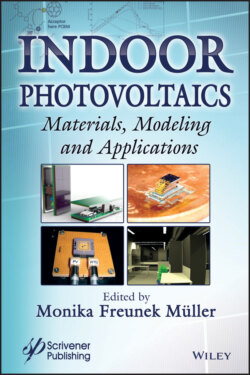Indoor Photovoltaics

Реклама. ООО «ЛитРес», ИНН: 7719571260.
Оглавление
Группа авторов. Indoor Photovoltaics
Table of Contents
List of Tables
List of Illustrations
Guide
Pages
Indoor Photovoltaics. Materials, Modeling and Applications
Preface
1 Will Photovoltaics Stay Out of the Shadows?
1.1 Introduction
References
Note
2 Introduction to Micro Energy Harvesting
2.1 Introduction and History
2.1.1 Brief History of Electric Generators and Loads
2.1.2 Forms of Energies and Energy Converters
2.2 Kinetic Energy
2.2.1 Oscillating Solid Objects
2.2.1.1 Human Motion
2.2.1.2 Vibrations
2.2.1.3 Flow of Gas and Fluids
2.2.1.4 Acoustic Vibrations
2.2.1.5 Elastic Energy
2.3 Thermoelectric Conversion
2.4 Electrochemical Potential
2.5 Electromagnetic Transmission
2.6 Atomic Batteries
2.7 Challenges
2.8 Conclusions and Outlook
Acknowledgment
References
Note
3 Introduction to Indoor Photovoltaics
3.1 Introduction
3.2 Indoor Spectra and Efficiencies
3.3 State of IPV Design, Issues, Approaches
3.4 Fields of Application
3.4.1 Customer and Office Applications
3.4.2 Ambient Assisted Living and Building Automatization
3.4.3 Industry, Agriculture, Horticulture, Retail, and Logistics
3.4.4 Relation of IPV to Outdoor Applications – Hiking, Emergency Kits
3.5 Degradation and Lifetime Issues
3.6 Conclusions and Outlook
References
Note
4 Modeling Indoor Irradiance
4.1 Introduction
4.2 Fundamentals
4.2.1 Photometry and Its Impact on IPV
4.2.2 Comparison Measurements of Different Luxmeter Products and Settings
4.2.3 Conclusions for Indoor Irradiance Measurements
4.2.4 Available Data on Indoor Irradiance
4.3 Radiometric Solutions
4.3.1 Structure
4.3.2 Settings of the Studied Rooms
4.3.3 Investigated Installation Points
4.4 Analytical Model. 4.4.1 Solar Radiation
4.4.2 Artifical Lighting
4.4.3 Interaction with Objects
Transmission
Reflection
4.4.4 Indirect Contributions of Solar Radiation
4.4.5 Final Results and Limits of Analytical Models
4.5 Simulations. 4.5.1 Ray Tracing: Fundamental Principles
4.5.2 Radiance
4.5.3 DAYSIM
4.5.4 Calculation Methods and Parameters
Calculation of Direct Radiation
Direct Subsampling “ds”
Direct Threshold “dt”
Calculation of Indirect Radiation
Ambient Bounces “ab”
Ambient Accuracy “aa”
4.5.5 Daylight Coefficient in DAYSIM
4.5.6 Environmental Parameters
4.5.7 Model Parameters. Room
Artificial Lighting
Daylight
User Behavior
4.5.8 Results. Required Complexity of a Simulation Model
Characteristic Values of Solar Radiation in Buildings
Electric Lighting—Influence and User Behavior
Time of Autarky with December as Example
4.5.9 Summary and Conclusion
4.6 Measurements. 4.6.1 Available Measurement Methods
Pyranometer
Pyrheliometer
Sunshine Duration Transmitters
Semiconductor-Based Radiation Sensors
Luxmeter
Spectroradiometer
Simulation Programs
4.6.2 Long-Term Measurements Reference Year
Results and Discussion
4.6.3 Validating Simulation
4.6.4 Comparison Measurement Methods under Controlled Conditions
4.7 Discussion and Recommendation
4.8 Conclusion and Outlook
4.8.1 Autarky Factors
4.9 Acknowledgements
4.10 Symbols and Abbreviations
4.11 Constants
4.12 Abbreviations
Appendix. A.1 Luxmeter Accuracy
A.2 Geometry and Materials in Radiance
A.3 Transmissivity Coefficient
References
Notes
5. Characterization and Power Measurement of IPV Cells
5.1 Features of IPV Compared to Outdoor PV
5.1.1 Irradiance
5.1.2.1 Consequences of the Different Spectra Regarding Efficiency
5.1.3 Incident Angle Distribution
5.1.4 Modulated Light Sources
5.1.5 Further Effects
5.1.6 Standardization
5.2 Calibration Chain and Quality Management
5.2.1 Basic Laboratory Measurement Methods for the Secondary Calibration of IPV Cells
5.3 Flexible and Precise Method for Comprehensive and Primary Calibration of IPV Devices
5.3.1 Lamp-Based Facility
5.3.2 Laser-Based Facility
5.4 DSR Calibration of IPV Cells
5.4.1 Self-Referenced IV Characteristic
Acknowledgment
References
Note
6. Luminescent Solar Concentrators
6.1 Introduction
6.2 A Crash Course in Luminescence
6.2.1 Luminescence in Organic Dyes
6.2.2 Luminescence in Rare Earth Ions
6.2.3 Luminescence in Quantum Dots
6.2.4 Hybrid Combinations
6.3 Principle of Operation
6.3.1 Absorption of Light
6.3.2 Emission within the LSC
6.3.3 Effects of Self-Absorption
6.3.4 Influence of the Waveguide
6.3.5 Conversion of Concentrated Light to Electricity
6.4 Calculating LSC Performance
6.4.1 Figures of Merit
6.4.2 Upper Bound for LSC Efficiency
6.4.3 Analytical Approach for Simple Geometries
6.4.4 Semi-Analytical Optimization Calculations for Arbitrary Geometries
6.4.5 Monte Carlo Simulations for Ray-Traced Complex Geometries
6.4.6 Considerations for Thin-Film LSCs
6.5 State-of-the-Art LSC Materials. 6.5.1 Measures for the Visual Performance of LSC Materials
6.5.2 Evaluating the Performance of State-of-the-Art LSCs
6.5.3 Dye-Based Luminescent Solar Concentrators
6.5.4 Rare Earth-Based Luminescent Solar Concentrators
6.5.5 Quantum Dot and Doped Quantum Dot-Based Luminescent Solar Concentrators
6.6 Tm2+-Doped Halide Luminescent Solar Concentrators
6.7 LSC for an IPV Perspective. 6.7.1 Performance Assessment
6.7.2 Application Examples
6.8 Conclusion
Acknowledgements
References
Notes
7. Organic Photovoltaic Cells and Modules for Applications under Indoor Lighting Conditions
7.1 Introduction
7.2 Implications of Indoor Lighting
7.3 OPV Modules
7.4 OPV Devices and Applications
7.5 Acceptance and Safety Considerations
References
Note
8. High-Efficiency Indoor Photovoltaic Energy Harvesting
8.1 Introduction
8.2 Approaches for Efficient Indoor PV Energy Harvesting. 8.2.1 PV Energy Harvesting Technologies
8.2.2 Commercial PV Energy Harvesting Devices
8.2.3 Recent Research Results for PV Energy Harvesting Devices
8.3 Lightricity’s PV Energy Harvesting Technology. 8.3.1 Introduction
8.3.2 Energy Harvester Device Fabrication and Device Characteristics
8.4 High-Efficiency PV Energy Harvesting Power Supplies. 8.4.1 Introduction
8.4.2 Energy Harvesting Power Management Solutions
8.4.3 System Integration and Performance Testing
8.5 Applications of Light Indoor Energy Harvesting
8.5.1 Watches and Wearable Devices
8.5.2 Wireless Building Automation Sensors
8.5.3 Wireless Beacons
8.6 Summary and Concluding Remarks
Acknowledgments
References
Note
9. Indoor Photovoltaics Based on AlGaAs
9.1 Importance of AlGaAs for Indoor Photovoltaics
9.2 Design Consideration for AlGaAs III-V Photovoltaic Cells
9.2.1 Base/Absorber
9.2.2 Contact
9.2.3 Window
9.2.4 Emitter
9.2.5 Back Surface Field
9.3 Large-Area AlGaAs III-V Photovoltaics
9.4 Small-Area AlGaAs Photovoltaics
9.4.1 Model of J-V Characteristics
9.4.2 Performance of mm-Scale AlGaAs Photovoltaics
9.4.3 Dark Current Limitations
9.5 Monolithic GaAs PV Cell Arrays
9.6 Conclusion
References
Note
Index
Also Edited by Monika Freunek Müller
WILEY END USER LICENSE AGREEMENT
Отрывок из книги
Scrivener Publishing 100 Cummings Center, Suite 541j JBeverly, MA 01915-6106
.....
with cp(x) defined as
and the rotor speed v as
.....